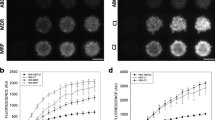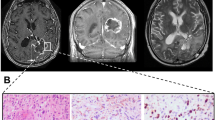Summary
A penetration assay based on freeze-drying and vapour fixation was applied to show the spatial distribution of non-bound and bound cytostatic drugs in cellular spheroids. Several studies have proposed that peripheral binding of drugs correlates with limited penetration. We showed that granular accumulation, mainly at the peripheral part of spheroids, might occur in parallel with good penetration. For example, this was the case in human glioma spheroids after incubation with Adriamycin for 15–30 min. Following treatment with actinomycin D, colon carcinoma spheroids exhibited rather good penetration but also showed granular accumulation mainly in their peripheral regions. Ara-C accumulated largely and homogeneously in the peripheral regions of colon carcinoma spheroids and this severely delayed penetration. It took about 1 h for ara-C in the central regions of the spheroids to reach the same concentration as in the culture medium. In contrast, ara-C easily penetrated glioma spheroids without accumulating noticeably at the periphery. Retention tests involving washing and further incubation in drug-free culture medium revealed that the areas demonstrating extensive accumulation most often retained the drug, indicating binding, whereas the concentration of drug in other areas decreased. The oil-centrifugation method, which was used for rapid separation of the spheroids from the drug-containing medium, showed that the average concentration of daunomycin in the spheroids exceeded that in the culture medium as early as after 15 min, by which time only limited penetration had occurred. We found that good penetration of ara-C correlated with a low average concentration in glioma spheroids, whereas limited penetration correlated with a high average concentration in colon carcinoma spheroids. The latter finding was attributable to the high accumulation of drug at the spheroid periphery. Thus, there was an inverse relationship between penetration and binding and between penetration and average drug concentration. It seemed that binding delayed or prevented penetration, whereas little, if any binding resulted in better penetration. Granular binding such as that observed Adriamycin and actinomycin D gave intermediatley good penetration.
Similar content being viewed by others
References
Acker H, Carlsson J, Holtermann G, Nederman T, Nylén T (1987) Influence of glucose and buffer capacity in the culture medium on growth and pH in spheroids of human thyroid carcinoma and human glioma origin. Cancer Res 47:3504
Carlsson J, Acker H (1988) Relations between pH, oxygen partial pressure and growth in cultured cell spheroids. Int J Cancer 42:715
Carlsson J, Nederman T (1989) Tumour spheroid technology in cancer therapy research. Eur J Clin Oncol 25:1127
Carlsson J, Yuhas J (1984) Liquid overlay culture of cellular spheroids. In: Acker H, Carlsson J, Durand RE, Sutherland RM (eds) Recent results in cancer research, vol 95. Spheroids in cancer research: methods and perspectives. Springer, Berlin Heidelberg New York, p 1
Carlsson J, Nilsson K, Westermark B, Pontén J, Sundström C, Larsson E, Bergh J, Påhlman S, Busch C, Collins VP (1983) Formation and growth of multicellular spheroids of human origin. Int J Cancer 31:523
Carlsson J, Daniel-Szolgay E, Frykholm G, Glimelius B, Hedin A, Larsson B (1989) Homogeneous penetration but heterogeneous binding of antibodies to carcinoembryonic antigen in human colon carcinoma HT-29 spheroids. Cancer Immunol Immunother 30:269
Chan T (1989) Augmentation of 1-β-d-arabinofuranosylcytosine cytotoxicity in human tumor cells by inhibiting drug efflux. Cancer Res 49:2656
Durand RE (1981) Flow-cytometry studies of intracellular Adriamycin in multicell spheroids in vitro. Cancer Res 41:3495
Durand RE (1986) Chemosensitivity testing in V 79 spheroids: drug delivery and cellular microenvironment. J Natl Cancer Inst 77:247
Durand RE (1989) Distribution and activity of antineoplastic drugs in a tumor model. J Natl Cancer Inst 81:146
Durand RE (1990) Multicell spheroids as a model for cell kinetic studies. Cell Tissue Kinet 23:141
Durand RE (1990) Slow penetration of anthracyclines into spheroids and tumors: a therapeutical advantage? Cancer Chemother Pharmacol 26:198
Durand RE, Olive P (1981) Flow cytometric studies of intracellular Adriamycin in single cells in vitro. Cancer Res 41:3489
Eisenstaedt RS, Neilan BA, Bartolucci A (1987) 5-Fluorouracil and cytarabine-ineffective treatment in advanced colorectal carcinoma: a Southeastern Cancer Study Group trial. Cancer Treat Rep 71:779
Erlichman C, Vidgen D (1984) Cytotoxicity of Adriamycin in MGHUl cells grown as monolayer cultures, spheroids and xenografts in immune-deprived mice. Cancer Res 44:5369
Erlichman C, Vidgen D, Wu A (1985) Cytotoxicity of cisplatin andcis-diammine-1,1-cyclobutane dicarboxylate in MGH-Ul cells grown as monolayers, spheroids and xenografts. J Natl Cancer Inst 75:499
Freyer JP (1988) Role of necrosis in regulating the growth saturation of multicellular spheroids. Cancer Res 48:2432
Freyer JP, Sutherland RM (1983) Determination of diffusion constants for metabolites in multicell tumor spheroids. In: Bicher HL, Bruley DF (eds) Oxygen transport to tissue. Plenum, New York, p 463
Glimelius B, Norling B, Nederman T, Carlsson J (1988) Extracellular matrices in multicellular spheroids of human glioma origin. Increased incorporation of proteoglycans and fibronectin as compared to monolayer cultures. Acta Pathol Microbiol Immunol Scand [A] 96:433
Inoue S, Ohnuma T, Takaoka K, Suzuki Y, Kaneko M, Safirstein R, Holland JF (1987) Effects of doxorubicin and cisplatin on multicellular tumor spheroids from human lung cancer. Cancer Drug Deliv 4:213
Kerr DJ, Kaye SB (1987) Aspects of cytotoxic drug penetration, with particular reference to anthracyclines. A review. Cancer Chemother Pharmacol 14:96
Kerr DJ, Wheldon TE, Hydes S, Kaye SB (1988) Cytotoxic drug penetration studies in multicellular tomour spheroids. Xenobiotica 18:641
Kohno N, Ohnuma T, Kaneko M, Holland JF (1988) Interactions of doxorubicin and cis-platin in squamous carcinoma cells in culture. Br J Cancer 58:330
Kwok TT, Twentyman PR (1985) The response to cytotoxic drugs of EMT6 cells treated as either intact or disaggregated spheroids. Br J Cancer 51:211
Lees RK, Sordat B, MacDonald HR (1981) Multicellular human spheroids of human colon carcinoma origin F kinetic analysis of infiltration and in situ destruction in a xenogeneic (murine) host. Exp Cell Biol 49:207
Nederman T, Carlsson J (1984) Penetration and binding of vinblastine and 5-fluorouracil in cellular spheroids. Cancer Chemother Pharmacol 13:131
Nederman T, Carlsson J, Malmqvist M (1981) Penetration of substances into tumor tissue-a methodological study on cellular spheroids. In Vitro 17:290
Nederman T, Norling B, Glimelius B, Carlsson J, Brunk U (1984) Demonstration of an extracellular matrix in multicellular tumour spheroids. Cancer Res 44: 3090
Nederman T, Carlsson J, Kuoppa K (1988) Penetration of substances into tumour tissue—model studies using saccharides, thymidine and thymidine-5-triphosphate in cellular spheroids. Cancer Chemother Pharmacol 22:21
Paterson ARP (1981) Transport of nucleosides and nucleoside analogs by animal cells. In: Sartorelli AC, Lazo JS, Bertino JR (eds) Molecular actions and targets for cancer chemotherapeutic agents. Academic Press, New York London Toronto Sydney San Francisco, p 213
Sutherland RM (1988) Cell and environment interactions in tumor microregions: the multicell spheroid model. Science 240:177
Sutherland RM, Eddy HA, Bareham B, Reich K, Vanatwerp D (1979) Resistance to Adriamycin in multicellular spheroids. Int J Radiat Oncol Biol Phys 5:1225
Sutherland RM, Sordert B, Barnat I, Gabbert H, Bourrat, B, Mueller-Klieser W (1986) Oxygenation and differentiation of multicellular spheroids of human colon carcinoma. Cancer Res 46:5320
Wallach DFH, Mikkelsen RB, Kwock L (1981) Plasma membranes as targets and mediators in tumor chemotherapy. In: Sartorelli AC, Lazo JS, Bertino JR (eds). Molecular actions and targets for cancer chemotherapeutic agents. Academic Press, New York London Toronto Sydney San Francisco, p 433
Verstijnen CP, Arends JW, Moerkerk PT, Geraedts, JP, Sekikawa K, Uitendaal MP, Bosman FT (1987) The establishment and characterization of two new cell lines derived from a single human colonic adenocarcinoma. Virchows Arch [B] 53:191
West GW, Weichselbaum R, Little JB (1980) Limited penetration of methotrexate into human osteosarcoma spheroids as a proposed model for solid tumor resistance to adjuvant chemotherapy. Cancer Res 40:3665
Westermark B, Pontén J, Hugosson R, (1973) Determinants for the establishment of permanent tissue culture lines from human gliomas. Acta Pathol Microbiol Immunol Scand [A] 81:791
Author information
Authors and Affiliations
Additional information
This work was financially supported by Swedish Cancer Society grants 1176-B90-03XA and 1079-B90-01XA, by Swedish National Board for Laboratory Animals grant 90-11, by Swedish National Board for Technical Development grant 88-03129P and by the Lions Cancer Foundation in the Umeå and Uppsala regions
Rights and permissions
About this article
Cite this article
Erlanson, M., Daniel-Szolgay, E. & Carlsson, J. Relations between the penetration, binding and average concentration of cytostatic drugs in human tumour spheroids. Cancer Chemother. Pharmacol. 29, 343–353 (1992). https://doi.org/10.1007/BF00686002
Received:
Accepted:
Issue Date:
DOI: https://doi.org/10.1007/BF00686002




